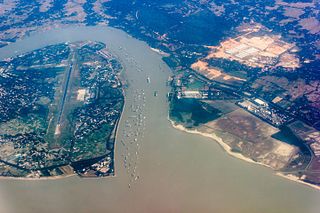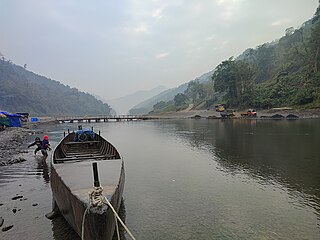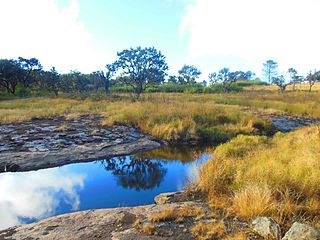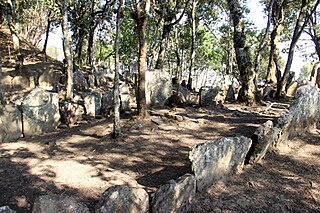
Mizoram is a landlocked state in northeast India, with Aizawl as its seat of government and largest city. Within India's northeast region, it is the southernmost state, sharing borders with three of the Seven Sister States, namely Tripura, Assam and Manipur, and also shares a 722-kilometre (449 mi) border with the neighbouring countries of Bangladesh and Myanmar. The state spans over an area of approximately 21,087 square kilometres, of which approximately 91% is forested. With an estimated population of 1.25 million in 2023, it is the second least populous state in the country.

The Karnaphuli River is the largest and most important river in Chittagong and the Chittagong Hill Tracts. It is a 667-metre (2,188 ft) wide river in the south-eastern part of Bangladesh. Originating from the Saithah village of Mamit district in Mizoram, India, it flows 270 kilometres (170 mi) southwest through Chattogram Hill Tracts and Chattogram into the Bay of Bengal. It is the fastest flowing river in Bangladesh, after the Padma. It is said to "represent the drainage system of the whole south-western part of Mizoram." Principal tributaries include the Kawrpui River or Thega River, Tuichawng River and Phairuang River. A large hydroelectric power plant was built on the Karnaphuli in the Kaptai region in the 1960s. The mouth of the river hosts the Port of Chattogram, the largest and busiest seaport of Bangladesh.

Lunglei, formerly known as Lungleh, is the second-largest town in Mizoram, northeastern India, situated in the south-central part of the state. The town served as the capital of British Mizoram from 1889 to 1898. It is situated 729 metres above sea level and is situated on a ridge surrounded by hills. Lunglei has an estimated population of 80,000 residents as of 2023.
Bairabi is a census town in Kolasib district in the state of Mizoram, India.
Sairang is a town in the Aizawl district of the Indian state of Mizoram.

Tlabung, formerly known as Demagiri, is a census town in Lunglei district in the Indian state of Mizoram.
William Williams was a Welsh Presbyterian missionary to Khasi Hills, northeast India, in the late 19th century. He was a son of a ship captain in Nanternis, a small village in Wales. Following his father's footstep he became a sailor for five years. Then he took a profession in carpentry for two years. After graduating in theology from East London Missionary Training Institute he became a pastor. Pursuing his ambition he became a missionary of the Welsh Calvinistic Methodist Foreign Mission to Khasi people in India from 1887 until his death. He died of typhoid in 1892.

The Kaladan Road Project is a US$484 million project connecting the eastern Indian seaport of Kolkata with Sittwe seaport in Rakhine State, Myanmar by sea. In Myanmar, it will then link Sittwe seaport to Paletwa in Chin State via the Kaladan river boat route, and then from Paletwa by road to Mizoram state in Northeast India. All components of the project, including Sittwe port and power, river dredging, Paletwa jetty, have been completed, except the under construction Zorinpui-Paletwa road. Originally, the project was scheduled to be completed by 2014, but end-to-end project is expected to be fully operational only by December 2023 as per November 2023 update.

The Serlui is a river of Mizoram, northeastern India. It flows through Kolasib district and is impounded by the Serlui B Dam.
The Teirei is a river of Mizoram, northeastern India, a tributary of the Tlawng River.

The Chhimtuipui river, also known as the Chhimmtuipi Lui or Kaladan river, is a river of Mizoram, northeastern India. It flows in a southerly direction through Myanmar.
The Tuirial is a river of Mizoram and Assam, northeastern India. It is also known as River Sonai, a tributary of Barak River. It flows in a northerly direction towards Cachar district and joins the Barak River at Dungripar Village near Sonai town. It is impounded by the Tuirial Dam.

The Tuivawl is a river of Mizoram, northeastern India. It flows in a northerly direction.
The Mengpui is a river of Mizoram, northeastern India. It rises near Lunglei town in Chhimtuipui district.
The Tut is a river of Mizoram, northeastern India. It is a tributary of the Tlawng River.
Mizoram is a land of rolling hills, valleys, rivers, and lakes in Northeast India. As many as 21 major hill ranges or peaks of different heights run through the length and breadth of the state, with plains scattered here and there. The average height of the hills to the west of the state is about 1,000 metres. These gradually rise to 1,300 metres to the east. Some areas, however, have higher ranges which go up to a height of over 2,000 metres.

Phawngpui National Park or Phawngpui Blue Mountain National Park is one of the two national parks of India in Mizoram, the other and the larger being Murlen National Park. It is about 300 km from the main city Aizawl, located in the Lawngtlai district, towards the southeast of Mizoram and relatively close to Burma. It bears the name of the mountain Phawngpui, often called the Blue Mountain of Mizoram, which is the highest mountain peak in the state, reaching 2,157 m asl. The national park covers the entire mountain along with the surrounding reserve forest.

Mizoram is a state in the northeast of India. Mizoram is considered by many as a beautiful place due to its landscape and pleasant climate. There have been many attempts to increase revenue through tourism but many potential tourists find the lack of amenities to be a hurdle. However, the State continues to promote itself and many projects have been initiated. The tourism ministry continues to maintain or upgrade its tourist lodges throughout the state. Foreign tourists are required to obtain an 'inner line permit' under the special permit before visiting. The permit can be obtained from Indian missions abroad for a limited number of days or direct from Mizoram Government authorities within India. The state is rich in bird diversity, which has the potentiality to make it a major birding destination. Mizoram is a stronghold for Mrs. Hume's pheasant. There is also a rare record of the wild water buffalo from the state. There are several past records of the Sumatran rhinoceros from Mizoram, then Lushai Hills. The small population of wild elephants can be seen in Ngengpui and Dampa Sanctuaries.

The following outline is provided as an overview of and topical guide to Mizoram:

Aizawl, formerly known as Aijal, is the capital city and the most populous city of Mizoram, India. It is also the third largest city in northeast India, after Guwahati and Agartala. It is situated atop a series of ridges, with an average elevation of around 1,132 metres above sea level. In 2024, the city has an estimated population of 405,000 people.













